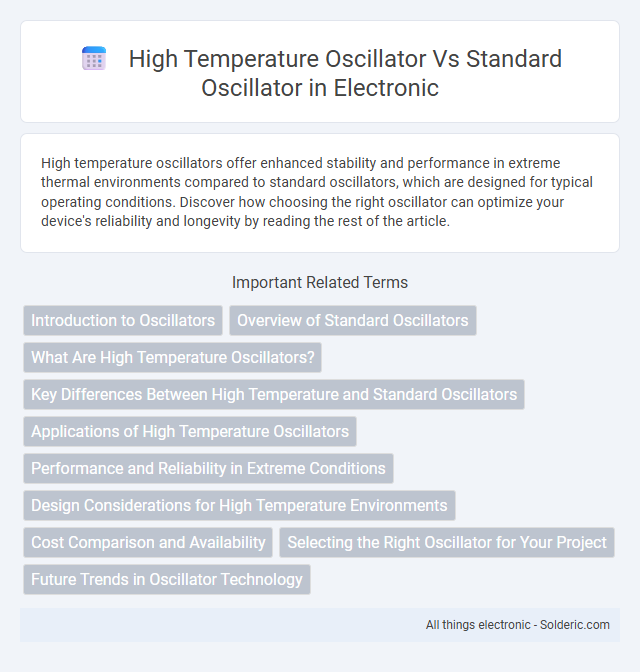High temperature oscillators offer enhanced stability and performance in extreme thermal environments compared to standard oscillators, which are designed for typical operating conditions. Discover how choosing the right oscillator can optimize your device's reliability and longevity by reading the rest of the article.
Comparison Table
| Feature | High Temperature Oscillator | Standard Oscillator |
|---|---|---|
| Operating Temperature Range | Up to +225degC | Typically -40degC to +85degC |
| Frequency Stability | +-5 ppm at high temperatures | +-20 ppm at room temperature |
| Application | Harsh environments, aerospace, automotive | Consumer electronics, standard industrial use |
| Material Composition | High-grade quartz or silicon carbide | Standard quartz crystal |
| Power Consumption | Typically higher due to temperature compensation | Lower power, optimized for normal conditions |
| Cost | Higher, specialized manufacturing processes | Lower, mass-produced components |
| Reliability | Enhanced for extreme conditions | Suitable for general conditions |
Introduction to Oscillators
High temperature oscillators are specifically designed to maintain stable frequency output under extreme thermal conditions, often exceeding 125degC, making them essential for aerospace and automotive applications. Standard oscillators typically operate within ambient temperature ranges of -40degC to 85degC, suitable for general electronic devices and consumer electronics. The choice between high temperature and standard oscillators depends on the environmental demands and required frequency stability for accurate signal processing.
Overview of Standard Oscillators
Standard oscillators provide reliable frequency generation for a wide range of electronic applications, operating within typical temperature ranges of -40degC to 85degC. These oscillators commonly use quartz crystal technology to ensure stability and accuracy in consumer electronics, automotive systems, and communication devices. Your choice of a standard oscillator suits many general purposes but may not perform optimally in high-temperature environments requiring specialized high temperature oscillators.
What Are High Temperature Oscillators?
High temperature oscillators are specialized timing devices designed to operate reliably in extreme thermal environments, often exceeding 125degC and up to 250degC, making them ideal for aerospace, automotive, and industrial applications. These oscillators use advanced quartz or MEMS resonators with temperature-compensated circuits to maintain signal stability and frequency accuracy despite significant heat exposure. In contrast, standard oscillators typically function at temperatures up to 85degC and lack the robust design required for high-temperature durability and consistent performance under severe thermal stress.
Key Differences Between High Temperature and Standard Oscillators
High temperature oscillators are designed to operate reliably in extreme environments up to 225degC, featuring specialized materials and packaging to withstand thermal stress, unlike standard oscillators which typically function within -40degC to 85degC. The stability and accuracy of high temperature oscillators are maintained through advanced compensation techniques that reduce frequency drift, whereas standard oscillators may exhibit significant performance degradation at elevated temperatures. Additionally, high temperature oscillators often incorporate ruggedized components for enhanced durability in aerospace, automotive, and industrial applications, distinguishing them from conventional oscillators mainly used in consumer electronics.
Applications of High Temperature Oscillators
High temperature oscillators are specifically engineered for environments exceeding 125degC, making them ideal for aerospace, automotive engine control, and oil and gas exploration where standard oscillators fail due to thermal stress. These devices maintain frequency stability and reliability under extreme heat, ensuring precise timing in harsh conditions critical to Your mission-critical systems. Their robustness extends the operational life of electronics in industrial sensors, downhole drilling equipment, and power generation turbines.
Performance and Reliability in Extreme Conditions
High temperature oscillators maintain stable frequency output and enhanced reliability in extreme conditions up to 225degC, outperforming standard oscillators designed for typical industrial ranges of -40degC to 85degC. Their robust construction and specialized materials minimize frequency drift and failure rates under thermal stress, making them ideal for aerospace, automotive, and oil exploration applications. Your systems benefit from consistent timing accuracy and reduced downtime when using high temperature oscillators in harsh environments.
Design Considerations for High Temperature Environments
High temperature oscillators require materials with superior thermal stability, such as silicon carbide or quartz, to maintain frequency accuracy in extreme environments above 125degC. Design considerations include robust packaging to prevent thermal-induced mechanical stress and the integration of temperature compensation circuits to minimize frequency drift. In contrast, standard oscillators typically use less thermally resilient materials and simpler packaging, suitable for moderate temperature ranges around -40degC to 85degC.
Cost Comparison and Availability
High temperature oscillators typically cost significantly more than standard oscillators due to their specialized materials and robust design required for extreme environments, such as aerospace and industrial applications. Availability of high temperature oscillators is limited as they are produced by fewer manufacturers and often require longer lead times compared to widely available standard oscillators used in consumer electronics. Despite the higher cost and lower availability, high temperature oscillators provide critical reliability where standard oscillators would fail.
Selecting the Right Oscillator for Your Project
High temperature oscillators operate reliably in extreme conditions up to 200degC, making them ideal for aerospace, automotive, and industrial applications requiring precision and durability. Standard oscillators typically function within a temperature range of -40degC to 85degC, suitable for consumer electronics and general-purpose uses. Selecting the right oscillator involves evaluating the operational environment, temperature tolerance, frequency stability, and application-specific reliability demands to ensure optimal performance and longevity.
Future Trends in Oscillator Technology
Future trends in oscillator technology emphasize the advancement of high temperature oscillators designed to operate reliably in extreme environments, such as aerospace, automotive, and industrial applications where temperatures exceed 200degC. Innovations include the integration of silicon carbide (SiC) and gallium nitride (GaN) materials, which offer superior thermal stability and frequency precision compared to standard quartz oscillators. These developments enable enhanced performance in harsh conditions, fostering expanded use in next-generation communications, sensor networks, and high-frequency radar systems.
High temperature oscillator vs Standard oscillator Infographic

 solderic.com
solderic.com